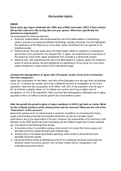Discussion topics
Japan
Some years ago Japan celebrated the 150th year of Meji restoration (1853). Prime minister
Shinzo Abe referred to this during this new year speech. What were specifically the
elements he emphasized?
He emphasized the following elements:
● Economic modernization: Abe emphasized the role of the Meiji leaders in modernizing
Japan's economy by embracing Western technology, industry and trade. He also highlighted
the significance of the Meiji era as a time when Japan transitioned from an agrarian to an
industrial society.
● Political reform: Abe also spoke about the Meiji leaders' efforts to establish a constitutional
government and a parliament, the Imperial Diet, in Japan. He emphasized the importance of
this period as a time when Japan transitioned from a feudal to a democratic society.
● National unity: Abe emphasized the role of the Meiji leaders in unifying Japan and creating a
sense of national identity. He also highlighted the significance of this period as a time when
Japan emerged as a major power on the international stage
Compare the demographics of Japan with a European country. Draw some conclusions
from this comparison.
Japan has a population of 126 million, with 25% of the population over the age of 65. Its birthrate
is low, at 1.4 children per woman, and it has a relatively low level of immigration, at 2% of the
population. Germany has a population of 83 million, with 20% of the population over the age of
65. Its birthrate is slightly higher, at 1.6 children per woman, and it has a higher level of
immigration, at 13% of the population. Both countries face demographic challenges due to aging
population which can affect economic growth and social welfare system.
After the growth the growth engine of Japan sputtered. In 2012 it got back on tracks. What
are the underlying factors of the slowing down and the recovery? What was the role of the
“Abenomics” in this process?
Abenomics policies led to an improvement in economic conditions, by increasing the money
supply and boosting consumer and business sentiment, as well as a stronger export
performance due to the depreciation of the yen. However, the sustainability of the recovery is still
debated, as the GDP growth has been fluctuating and the inflation target has not been reached
yet. It focussed on the following three arrows:
● A monetary policy of quantitative easing, which aimed to increase the money supply and
stimulate economic growth through lower interest rates.
● A fiscal policy of increased government spending, which aimed to boost demand and
stimulate economic growth.
● Structural reforms aimed at addressing some of the underlying structural issues that had
hindered Japan's economic growth, such as labor market reform, deregulation, and
corporate governance reform.
, How are Japanese companies dealing with the problem of work-related decease and
suicide while they are facing a permanent pressure to increase productivity?
Japanese companies are facing a significant challenge in addressing the problem of work-related
diseases and suicide, which are both linked to the intense pressure to increase productivity.
Some of the measures that Japanese companies are taking to address these issues include:
● Implementing flexible working hours and remote work options to reduce the stress and long
hours associated with "karōshi," or death from overwork.
● Introducing mental health support programs and counseling services for employees to
address issues such as stress and burnout.
● Encouraging and fostering a culture of work-life balance, where employees are encouraged
to take time off and prioritize their health and well-being.
● Implementing a system of regular health check-ups and monitoring the health of employees
to identify and address any issues early.
● Creating a reporting system for work-related diseases, and taking actions to prevent further
cases
● Providing training and education programs on mental health and stress management.
Despite these efforts, the problem of work-related diseases and suicide remains a significant
challenge for Japanese companies. Companies are facing a permanent pressure to increase
productivity while also trying to address the social and health issues caused by overwork.
The government has also taken some steps by revising laws and regulations to limit
overwork, but it's a complex issue that requires a multi-stakeholder approach. The cultural
perception of work and the pressure to work long hours is deeply ingrained in Japanese
society and it will take time for the efforts to show significant results.
Can Belgian companies learn something from the 14 Toyota principles?
Respect for people: Toyota places a strong emphasis on respect for people, and encourages its
employees to work together as a team and to be empowered to make decisions. This principle
can be applied to Belgian companies by fostering a culture of respect, trust, and collaboration
among employees.
South Korea
Analyse the 5 most digitized countries in the world. What is the place of South Korea.
What are its strengths and weaknesses?
South Korea is considered one of the most digitized countries in the world, being listed at #2. It
has a strong ICT infrastructure, high internet and mobile connectivity, and fast internet speed.
The government actively promotes digitalization and has invested in ICT infrastructure. The
population is tech-savvy and well-educated. However, the country is facing challenges such as a
lack of cybersecurity, digital divide and digital literacy.




